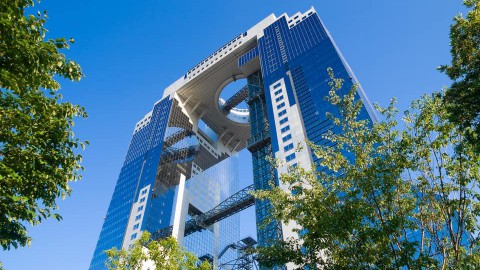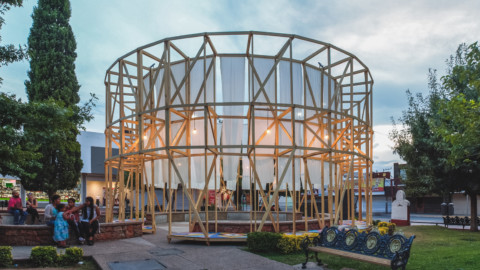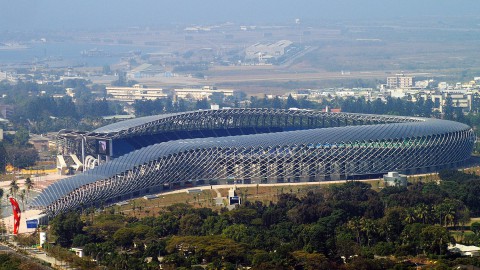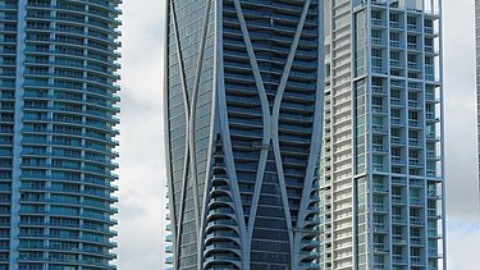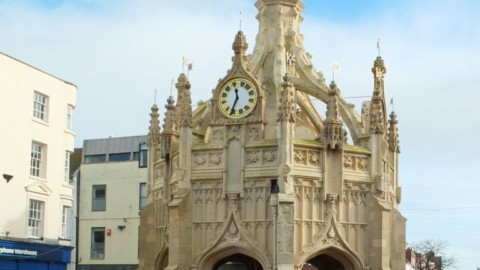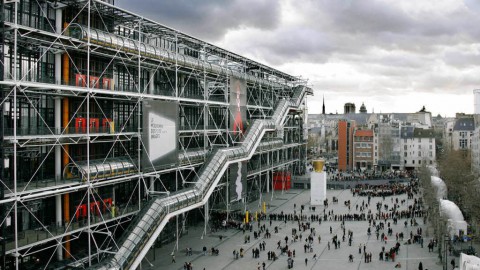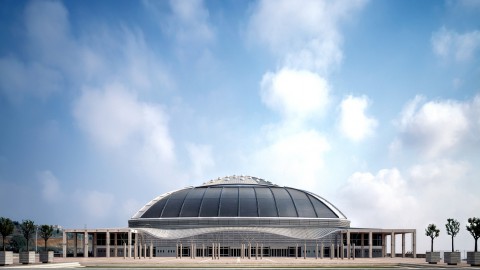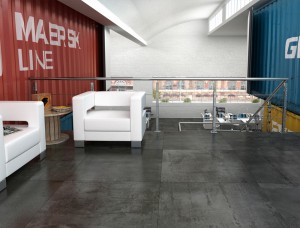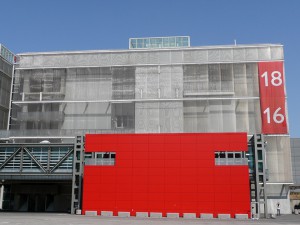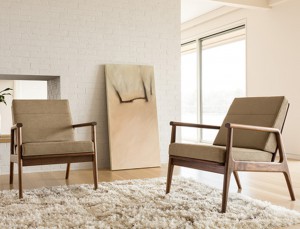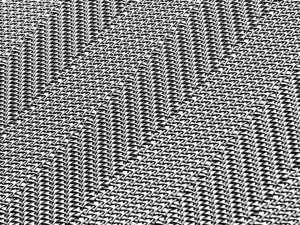Opéra de Paris 巴黎歌劇院

The Palais Garnier (pronounced [palɛ ɡaʁnje] French About this sound (help·info)) is a 1,979-seat opera house, which was built from 1861 to 1875 for the Paris Opera. It was called the Salle des Capucines, because of its location on the Boulevard des Capucines in the 9th arrondissement of Paris, but soon became known as the Palais Garnier, in recognition of its opulence and its architect, Charles Garnier. The theatre is also often referred to as the Opéra Garnier (pronounced [ɔpeʁa ɡaʁnje] French About this sound (help·info)) and historically was known as the Opéra de Paris or simply the Opéra, as it was the primary home of the Paris Opera and its associated Paris Opera Ballet until 1989, when the Opéra Bastille opened at the Place de la Bastille. The Paris Opera now mainly uses the Palais Garnier for ballet.
The Palais Garnier has been called “probably the most famous opera house in the world, a symbol of Paris like Notre Dame Cathedral, the Louvre, or the Sacré Coeur Basilica.” This is at least partly due to its use as the setting for Gaston Leroux’s 1910 novel The Phantom of the Opera and, especially, the novel’s subsequent adaptations in films and the popular 1986 musical. Another contributing factor is that among the buildings constructed in Paris during the Second Empire, besides being the most expensive, it has been described as the only one that is “unquestionably a masterpiece of the first rank.” This opinion is far from unanimous however: the 20th-century French architect Le Corbusier once described it as “a lying art” and contended that the “Garnier movement is a décor of the grave”.
The Palais Garnier also houses the Bibliothèque-Musée de l’Opéra de Paris (Paris Opera Library-Museum), although the Library-Museum is no longer managed by the Opera and is part of the Bibliothèque Nationale de France.The museum is included in unaccompanied tours of the Palais Garnier.
Palais Garnier(發音為[palɛɡaʁnje] French關於這個聲音(幫助·信息))是一個擁有1,979個座位的歌劇院,建於1861年至1875年,為巴黎歌劇院。它被稱為Salle des Capucines,因為它位於巴黎第9區的Capucines大道,但很快就被稱為卡尼爾宮,以表彰它的富裕和建築師Charles Garnier。劇院也經常被稱為卡尼爾歌劇院(發音為[ɔpeʁaɡaʁnje]法語關於這個聲音(幫助·信息))和歷史上被稱為巴黎歌劇院或簡稱歌劇院,因為它是巴黎的主要家園歌劇院及其相關的巴黎歌劇芭蕾舞團直到1989年,當時巴士底歌劇院在巴士底廣場開幕。巴黎歌劇院現在主要使用Palais Garnier芭蕾舞劇。
卡尼爾宮被稱為“可能是世界上最著名的歌劇院,巴黎象徵著巴黎圣母院,盧浮宮或聖心大教堂。”這至少部分是由於它被用作Gaston Leroux的1910年小說“歌劇魅影”的背景,特別是小說隨後在電影中的改編和1986年流行的音樂劇。另一個影響因素是,在第二帝國時期在巴黎建造的建築物中,除了最昂貴之外,它被描述為唯一一個“毫無疑問是第一等級的傑作”。然而,這種觀點遠非一致:20世紀的法國建築師勒·柯布西耶曾將其描述為“一種說謊的藝術”,並認為“卡尼爾運動是墳墓的裝飾”。
卡尼爾宮(Palais Garnier)還設有巴黎歌劇院(巴黎歌劇院圖書館 – 博物館),儘管圖書館博物館不再由歌劇院管理,也是法國國家圖書館(BibliothèqueNationalede France)的一部分。博物館包含在卡尼爾宮無人陪伴遊覽。
General information
Type:Opera house
Architectural style:Second Empire and Beaux-Arts
Location:Place de l’Opéra,
9th arrondissement,
Paris, France
Coordinates:48°52′19″N 2°19′54″ECoordinates: 48°52′19″N 2°19′54″E
Construction started:August 1861
Inaugurated:5 January 1875
Cost:36,010,571.04 francs
(as of 20 November 1875)
Height:56 metres (184 ft) from ground level to the apex of the stage flytower; 32 metres (105 ft) to the top of the facade
Dimensions
Other dimensions:154.9 metres (508 ft) long; 70.2 metres (230 ft) wide at the lateral galleries; 101.2 metres (332 ft) wide at the east and west pavilions; 10.13 metres (33.2 ft) from ground level to bottom of the cistern under the stage
Technical details
Structural system:masonry walls; concealed iron floors, vaults, and roofs
Design and construction
Architect:Charles Garnier
Other information
Seating capacity: 1,900
一般信息
類型:歌劇院
建築風格:第二帝國和美術
地點:Place de l’Opéra,
第9區,
法國巴黎
坐標:48°52’19“N 2°19’54”ECoordinates:48°52’19“N 2°19’54”E
施工開始:1861年8月
開幕式:1875年1月5日
費用:36,010,571.04法郎
(截至1875年11月20日)
高度:從地面到舞台飛行塔頂點56米(184英尺); 距離立面頂部32米(105英尺)
外形尺寸
其他尺寸:長154.9米(508英尺); 在側廊上寬70.2米(230英尺); 東,西亭閣寬101.2米(332英尺); 從地面到地下水池底部10.13米(33.2英尺)
技術細節
結構系統:磚石牆; 隱藏的鐵地板,拱頂和屋頂
設計和施工
建築師:Charles Garnier
其他信息
座位數:1,900
The opera was constructed in what Charles Garnier (1825-1898) is said to have told the Empress Eugenie was “Napoleon III” styleThe Napoleon III style was highly eclectic, and borrowed from many historical sources; the opera house included elements from the Baroque, the classicism of Palladio, and Renaissance architecture blended together.These were combined with axial symmetry and modern techniques and materials, including the use of an iron framework, which had been pioneered in other Napoleon III buildings, including the Bibliotheque Nationale and the markets of Les Halles.
The facade and the interior followed the Napoleon III style principle of leaving no space without decoration. Garnier used polychromy, or a variety of colors, for theatrical effect, achieved different varieties of marble and stone, porphyry, and gilded bronze. The facade of the Opera used seventeen different kinds of material, arranged in very elaborate multicolored marble friezes, columns, and lavish statuary, many of which portray deities of Greek mythology.
這部歌劇是根據據說查爾斯·加尼爾(1825-1898)告訴皇后歐仁妮的“拿破崙三世”風格而構建的。拿破崙三世的風格非常折衷,並藉鑑了許多歷史資料;歌劇院包括巴洛克風格的元素,帕拉迪奧的古典主義和文藝復興時期的建築融合在一起。這些結合了軸對稱和現代技術和材料,包括使用鐵框架,這是其他拿破崙三世建築中的先驅,包括Bibliotheque Nationale和Les Halles市場。
立面和內飾遵循拿破崙三世風格的原則,沒有裝飾就沒有空間。卡尼爾使用多色或多種顏色進行戲劇效果,獲得了不同品種的大理石和石頭,斑岩和鍍金青銅。歌劇院的外立面使用了十七種不同的材料,佈置在非常精緻的五彩繽紛的大理石裝飾柱,柱子和奢華的雕像中,其中許多描繪了希臘神話中的神靈。


The principal facade is on the south side of the building, overlooking the Place de l’Opéra and terminates the perspective along the Avenue de l’Opéra. Fourteen painters, mosaicists and seventy-three sculptors participated in the creation of its ornamentation.
The two gilded figural groups, Charles Gumery’s L’Harmonie (Harmony) and La Poésie (Poetry), crown the apexes of the principal facade’s left and right avant-corps. They are both made of gilt copper electrotype.
The bases of the two avant-corps are decorated (from left to right) with four major multi-figure groups sculpted by François Jouffroy (Poetry, also known as Harmony), Jean-Baptiste Claude Eugène Guillaume (Instrumental Music), Jean-Baptiste Carpeaux (The Dance, criticised for indecency), and Jean-Joseph Perraud (Lyrical Drama). The facade also incorporates other work by Gumery, Alexandre Falguière, and others.
Gilded galvanoplastic bronze busts of many of the great composers are located between the columns of the theatre’s front façade and depict, from left to right, Rossini, Auber, Beethoven, Mozart, Spontini, Meyerbeer, and Halévy. On the left and right lateral returns of the front facade are busts of the librettists Eugène Scribe and Philippe Quinault, respectively.
主立面位於建築的南側,俯瞰歌劇院廣場,並沿著歌劇院大道終止視角。十四位畫家,鑲嵌畫家和七十三位雕塑家參與了其裝飾的創作。
兩個鍍金的圖形組織,Charles Gumery的L’Harmonie(和諧)和LaPoésie(詩歌),是主要立面的左右前衛的頂點。它們均由鍍金銅電鍍製成。
兩個先鋒隊的基地裝飾(從左到右)由FrançoisJouffroy(詩歌,也稱為和諧)雕刻的四個主要多人物組,Jean-BaptisteClaudeEugèneGuillaume(器樂),Jean-Baptiste Carpeaux(舞蹈,因猥褻而受到批評)和Jean-Joseph Perraud(抒情劇)。門面還包括Gumery,AlexandreFalguière和其他人的其他作品。
許多偉大作曲家的鍍金電鍍青銅半身像位於劇院前立面的柱子之間,從左到右描繪了羅西尼,奧伯,貝多芬,莫扎特,Spontini,梅耶貝爾和哈雷維。在前立面的左右側面回歸分別是劇作家EugèneScribe和Philippe Quinault的半身像。

The sculptural group Apollo, Poetry, and Music, located at the apex of the south gable of the stage flytower, is the work of Aimé Millet, and the two smaller bronze Pegasus figures at either end of the south gable are by Eugène-Louis Lequesne.
雕塑集團阿波羅,詩歌和音樂,位於舞台飛塔的南山牆的頂點,是AiméMillet的作品,南部山牆兩端的兩個較小的青銅飛馬座人物是Eugène-Louis Lequesne。


Also known as the Rotonde de l’Empereur, this group of rooms is located on the left (west) side of the building and was designed to allow secure and direct access by the Emperor via a double ramp to the building. When the Empire fell, work stopped, leaving unfinished dressed stonework. It now houses the Bibliothèque-Musée de l’Opéra de Paris (Paris Opera Library-Museum) which is home to nearly 600,000 documents including 100,000 books, 1,680 periodicals, 10,000 programs, letters, 100,000 photographs, sketches of costumes and sets, posters and historical administrative records.
這組房間也被稱為Rotonde de l’Empereur,位於建築物的左側(西側),旨在通過雙層坡道安全直接進入建築物。 當帝國倒下時,工作停止了,留下未完成的穿著石雕。 它現在擁有巴黎歌劇院圖書館(巴黎歌劇院圖書館),這裡有近600,000份文件,包括10萬本書籍,1,680種期刊,10,000個節目,信件,10萬張照片,服裝和集合的草圖,海報和 歷史行政記錄。
Located on the right (east) side of the building as a counterpart to the Pavillon de l’Empereur, this pavilion was designed to allow subscribers (abonnés) direct access from their carriages to the interior of the building. It is covered by a 13.5-metre diameter dome. Paired obelisks mark the entrances to the rotunda on the north and the south.
該展館位於建築物的右側(東側),與Pavillon de l’Empereur相對應,旨在讓訂戶(abonnés)直接從他們的車廂進入建築物內部。 它由直徑13.5米的圓頂覆蓋。 成對的方尖碑標誌著北部和南部圓形大廳的入口。

The interior consists of interweaving corridors, stairwells, alcoves and landings, allowing the movement of large numbers of people and space for socialising during intermission. Rich with velvet, gold leaf, and cherubim and nymphs, the interior is characteristic of Baroque sumptuousness.
內部由交織的走廊,樓梯間,壁龕和平台組成,允許大量人員的移動和空間在中場休息期間進行社交。 豐富的天鵝絨,金箔,基路伯和若蟲,內飾是巴洛克式的奢華特色。
The building features a large ceremonial staircase of white marble with a balustrade of red and green marble, which divides into two divergent flights of stairs that lead to the Grand Foyer. Its design was inspired by Victor Louis’s grand staircase for the Théâtre de Bordeaux. The pedestals of the staircase are decorated with female torchères, created by Albert-Ernest Carrier-Belleuse. The ceiling above the staircase was painted by Isidore Pils to depict The Triumph of Apollo, The Enchantment of Music Deploying its Charms, Minerva Fighting Brutality Watched by the Gods of Olympus, and The City of Paris Receiving the Plan of the New Opéra. When the paintings were first fixed in place two months before the opening of the building, it was obvious to Garnier that they were too dark for the space. With the help of two of his students, Pils had to rework the canvases while they were in place overhead on the ceiling and, at the age of 61, he fell ill. His students had to finish the work, which was completed the day before the opening and the scaffolding was removed.
該建築設有一個白色大理石的大型禮儀樓梯,配有紅色和綠色大理石欄杆,分為兩個不同的樓梯通向大門廳。其設計靈感來自Victor Louis的波爾多劇院(ThéâtredeBordeaux)的大樓梯。樓梯的基座裝飾有女性火炬,由Albert-Ernest Carrier-Belleuse創作。樓梯上方的天花板由Isidore Pils繪製,描繪了阿波羅的勝利,音樂的魅力展現其魅力,Minerva戰鬥的奧林匹斯眾神的殘暴,以及接受新歌劇計劃的巴黎市。當這些畫作在建築物開放前兩個月首次固定到位時,對於卡尼爾而言,它們對於太空來說太暗了。在他的兩個學生的幫助下,Pils不得不重新修改畫布,而它們在天花板上方,而在61歲時,他生病了。他的學生必須完成工作,工作在開幕前一天完成,腳手架被拆除。

This hall, 18 meters high, 154 meters long and 13 meters wide, was designed to act as a drawing room for Paris society. It was restored in 2004. Its ceiling was painted by Paul-Jacques-Aimé Baudry and represents various moments in the history of music. The foyer opens onto an outside loggia and is flanked by two octagonal salons with ceilings painted by Jules-Élie Delaunay in the eastern salon and Félix-Joseph Barrias in the western salon. The octagonal salons open to the north into the Salon de la Lune at the western end of the Avant-Foyer and the Salon du Soleil at its eastern end.
這座18米高,154米長,13米寬的大廳旨在充當巴黎社會的客廳。 它於2004年重建。它的天花板由Paul-Jacques-AiméBaudry繪製,代表了音樂史上的各種時刻。 門廳通向外面的涼廊,兩側是兩個八角形沙龍,天花板由東部沙龍的Jules-ÉlieDelaunay和西部沙龍的Félix-Joseph Barrias繪製。 八角形沙龍向北開放,位於Avant-Foyer西端的Salon de la Lune和東端的Salon du Soleil沙龍。


The auditorium has a traditional Italian horseshoe shape and can seat 1,979. The stage is the largest in Europe and can accommodate as many as 450 artists. The canvas house curtain was painted to represent a draped curtain, complete with tassels and braid.
The ceiling area which surrounds the chandelier was originally painted by Jules Eugène Lenepveu. In 1964 a new ceiling painted by Marc Chagall was installed on a removable frame over the original. It depicts scenes from operas by 14 composers – Mussorgsky, Mozart, Wagner, Berlioz, Rameau, Debussy, Ravel, Stravinsky, Tchaikovsky, Adam, Bizet, Verdi, Beethoven, and Gluck. Although praised by some, others feel Chagall’s work creates “a false note in Garnier’s carefully orchestrated interior.”
The seven-ton bronze and crystal chandelier was designed by Garnier. Jules Corboz prepared the model, and it was cast and chased by Lacarière, Delatour & Cie. The total cost came to 30,000 gold francs. The use of a central chandelier aroused controversy, and it was criticised for obstructing views of the stage by patrons in the fourth level boxes and views of the ceiling painted by Eugène Lenepveu. Garnier had anticipated these disadvantages but provided a lively defence in his 1871 book Le Théâtre: “What else could fill the theatre with such joyous life? Who else could offer the variety of forms that we have in the pattern of the flames, in these groups and tiers of points of light, these wild hues of gold flecked with bright spots, and these crystalline highlights?”
On 20 May 1896, one of the chandelier’s counterweights broke free and burst through the ceiling into the auditorium, killing a concierge. This incident inspired one of the more famous scenes in Gaston Leroux’s classic 1910 gothic novel The Phantom of the Opera.
Originally the chandelier was raised up through the ceiling into the cupola over the auditorium for cleaning, but now it is lowered. The space in the cupola was used in the 1960s for opera rehearsals, and in the 1980s was remodelled into two floors of dance rehearsal space. The lower floor consists of the Salle Nureïev (Nureyev) and the Salle Balanchine, and the upper floor, the Salle Petipa.
禮堂採用傳統的意大利馬蹄形,可容納1,979人。 舞台是歐洲最大的舞台,可容納多達450位藝術家。 帆布屋的窗簾被漆成了一個垂褶的窗簾,配有流蘇和辮子。
枝形吊燈周圍的天花板區最初由JulesEugèneLenepveu繪製。 1964年,由Marc Chagall繪製的新天花板安裝在原件上的可拆卸框架上。它描繪了14位作曲家的歌劇場景 – 穆索爾斯基,莫扎特,瓦格納,柏遼茲,拉莫,德彪西,拉威爾,斯特拉文斯基,柴可夫斯基,亞當,比才,威爾第,貝多芬和格魯克。雖然受到一些人的讚揚,但其他人認為夏加爾的作品在卡尼爾經過精心策劃的內飾中創造了“錯誤的音符”。
七噸青銅和水晶吊燈由卡尼爾設計。 Jules Corboz準備了這個模型,由Lacarière,Delatour&Cie演員和追逐。總成本達到30,000金法郎。中央枝形吊燈的使用引起了爭議,並且批評了第四層箱中的顧客用EugèneLenepveu繪製的天花板的視圖來阻礙舞台的觀點。卡尼爾已經預見到了這些不利因素,但在他1871年的“LeThéâtre”一書中提供了一個生動的辯護:“還有什麼能讓劇院充滿歡樂的生活?還有誰可以提供我們在火焰模式中所擁有的各種形式,在這些群體中還有一些光點,這些斑駁的金色斑點,以及這些晶瑩剔透的亮點?“
1896年5月20日,其中一個枝形吊燈的配重掙脫,從天花板突入禮堂,殺死了禮賓。這一事件激發了Gaston Leroux經典的1910年哥特小說“歌劇魅影”中最著名的一幕。
最初枝形吊燈通過天花板升到禮堂上方的圓屋頂進行清潔,但現在降低了。圓屋頂的空間在20世紀60年代用於歌劇排練,並在20世紀80年代被改造成兩層舞蹈排練空間。樓下包括SalleNureïev(Nureyev)和Salle Balanchine,以及Salle Petipa。


FROM:https://en.wikipedia.org/wiki/Palais_Garnier
FROM:Visit The Palais Garnier – Opéra de Paris
FROM:Opéra Garnier – Paris, France | Palais Garnier | Paris Opera House
Don’t you think it’s addictive?
Want to know more about the beauty of architecture?
Come and join our members to explore the beauty of architectural design.
覺得看得不過癮嗎?
想要知道更多建築之美嗎?
快來加入我們的會員,一同探索建築設計之美。
The above article is purely for appreciation and sharing purposes, as well as the construction of new technology and the public can be in-depth understanding of the information at the same time there are sources, will be able to query, no use of the document as a commercial transaction, if illegal, please inform the We will immediately remove the site, thank you for cooperation.
以上文章純粹作為欣賞及分享用途,以及將建築新型技術傳遞給與大眾能夠深入了解,同時資料還有來源,將可查詢,絕無使用該文件資料作為商業交易行為,如有違法請務必告知該網站我們將立即處理撤除,謝謝合作。


